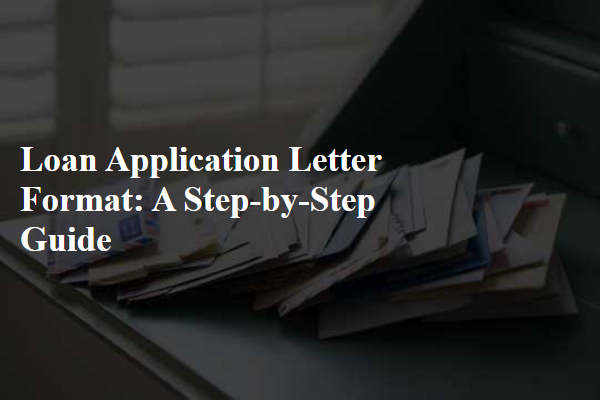
Avoid vague explanations or missing essential details such as the loan amount, purpose, and repayment plan to ensure clarity in your loan application letter. Refrain from using informal language or emotional appeals, which can undermine professionalism and credibility. Proofread thoroughly to eliminate spelling and grammatical errors that may negatively impact the lender's impression.
Incomplete Personal and Financial Information
Common mistakes in loan application letters include incomplete personal information, unclear purpose of the loan, and lack of supporting documents. Avoid vague statements and ensure all financial details are accurate and well-organized. Clear, concise, and honest communication increases the chances of loan approval.
Overlooking Required Documentation
| Mistake | Description | Impact | How to Avoid |
|---|---|---|---|
| Incomplete Personal Information | Missing or incorrect details such as name, contact information, or identification numbers. | Delays in processing or outright rejection of the loan application. | Double-check all personal details before submission. Use official documents as reference. |
| Lack of Clear Purpose | Failing to specify the reason for the loan or being vague about loan utilization. | Raises doubts about repayment plans and financial responsibility. | Clearly state the purpose of the loan, such as home purchase, business expansion, or education. |
| Poor Grammar and Formatting | Errors in writing, spelling mistakes, or unprofessional letter layout. | Creates a negative impression and suggests carelessness. | Proofread the letter, use proper formatting, and consider professional templates. |
| Omitting Financial Details | Not providing accurate income, expenses, or existing debt information. | Impedes the lender's ability to assess creditworthiness. | Include detailed and honest financial data with supporting documents. |
| Not Following Lender's Guidelines | Ignoring specific instructions or required documents stated by the lender. | May result in immediate rejection or need for resubmission. | Carefully read and follow all lender requirements and provide all requested documents. |
| Using Generic Templates without Personalization | Submitting a generic letter that lacks personal context or specifics. | Reduces credibility and the chance of approval. | Customize the letter to reflect your unique situation and relationship with the lender. |
Failing to State the Loan Purpose Clearly
Writing a clear and precise loan application letter increases your chances of loan approval. Avoid common mistakes that can lead to rejection.
- Incomplete Information - Providing missing or vague details confuses lenders and delays the process.
- Unprofessional Tone - Using informal language or errors reduces credibility and lowers trust.
- Ignoring Loan Purpose - Failing to clearly state why you need the loan weakens your application.
Ensuring accuracy and professionalism in your loan application letter strengthens your position with lenders.
Using Vague or Generic Language
What are common mistakes to avoid in your loan application letter? Errors such as unclear purpose and incomplete financial information can lead to rejection. Ensuring clarity and accuracy increases approval chances.
How important is it to tailor your loan application letter? Generic letters show lack of effort and reduce credibility. Personalizing the letter with specific details improves lender confidence.
Why should you avoid spelling and grammatical errors in your loan application? Mistakes signal unprofessionalism and carelessness. Proofreading guarantees a polished and trustworthy presentation.
What role does providing sufficient documentation play in your loan application? Submitting incomplete or missing documents delays processing and causes denials. Including all required paperwork strengthens your application.
How can exaggerating your income or financial status affect your loan application? Misrepresenting facts can lead to loss of trust and legal consequences. Honesty ensures a transparent and reliable communication with lenders.
Ignoring Lender's Specific Instructions
Loan application letters require clarity and professionalism to increase approval chances. Common mistakes can hinder the process and cause delays.
One frequent error is providing incomplete or inaccurate personal and financial information. This can lead to misunderstandings and application rejection.
Avoid using informal language or excessive technical jargon that may confuse the lender. Maintain a clear and polite tone throughout the letter.
Failing to include essential details, such as loan purpose and repayment plans, weakens your application. Double-check all documents and information before submission to ensure completeness.
Providing Inaccurate or False Details
Submitting a loan application letter with incomplete or inaccurate information can lead to delays or rejection. Avoid using vague language and ensure all financial details are clear and precise. Proofread the letter carefully to eliminate spelling and grammatical errors that may undermine your credibility.
Neglecting to Demonstrate Repayment Capability
Submitting a loan application letter with incomplete or inaccurate information can delay the approval process. Lenders require precise details to assess your creditworthiness effectively.
Failing to clearly state the loan purpose reduces the chances of approval. A well-defined objective helps lenders understand your need and the feasibility of repayment.
Submitting Poorly Structured or Unprofessional Letters
Submitting a well-crafted loan application letter increases the chances of approval and reflects financial responsibility. Avoiding common mistakes can make your application stand out to lenders.
- Incomplete Information - Providing all required personal, financial, and loan details prevents delays and shows preparation.
- Unclear Purpose - Clearly stating the loan purpose helps lenders assess the necessity and feasibility of the request.
- Poor Grammar and Formatting - Using professional language and proper formatting creates a positive impression and enhances readability.
Forgetting to Proofread for Errors
Writing a loan application letter requires clarity and professionalism to increase the chances of approval. Avoiding common mistakes ensures your request is taken seriously by lenders.
- Incomplete Information - Omitting essential details like loan amount, purpose, or repayment plan can delay or reject your application.
- Poor Formatting - A messy or unstructured letter can appear unprofessional and reduce credibility.
- Lack of Supporting Documents - Failing to attach necessary financial statements or identification weakens your loan request.
Omitting Contact Information or Next Steps
Loan application letters are crucial for securing financial support, but common mistakes can hinder approval. Avoiding errors ensures your letter presents you as a credible and responsible borrower.
One frequent mistake is failing to include essential personal and financial details, which can lead to delays or rejection. Using vague language or lacking clarity reduces the letter's impact and professionalism. Missing deadlines or submitting incomplete documents often results in automatic disqualification.



Comments